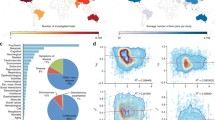Abstract
A simple extension of the DeFries and Fulker multiple regression model for twin analysis is applied to the problem of detecting linkage in a quantitative trait. The method, employing sib pairs, is based on that of Haseman and Elston. Reading data from 19 extended pedigrees were analyzed employing RLFPs as markers on chromosome 15 and using the widely available statistical applications software package, SAS. A number of possible linkages were detected, indicating that this approach is both powerful and effective, especially in the case of selected samples. Detecting genotype-environment interaction and the issue of power are briefly discussed. The programs used are available upon request.
Similar content being viewed by others
References
Blackwelder W. C. and Elston R. C. 1985. A comparison of sib-pair linkage tests for disease susceptibility loci. Genetic Epidemiology, 2, 85–97.
Cyphers L. H., Phillips K., Fulker D. W., and Mrazek D. A. 1990. Twin temperament during the transition from infancy to early childhood. American Academy of Child and Adolescent Psychiatry, 29, 392–397.
DeFries J. C. 1985. Colorado reading project. In D. B. Gray and J. F. Kavanagh (eds.), Biobehavioral Measures of Dyslexia (pp. 123–135). Parkton, MD: York Press.
DeFries J. C. and Fulker D. W. 1985. Multiple regression analysis of twin data. Behavior Genetics, 15, 467–473.
DeFries J. C. and Fulker D. W. 1988. Multiple regression analysis of twin data: Etiology of deviant scores versus individual differences. Acta Geneticae Medicae et Gemellologiae, 37, 205–216.
DeFries J. C., Olson R. K., Pennington B. F., and Smith S. D. 1991. Colorado Reading Project: An update. In D. B. Gray and D. Duane (eds.), The Reading Brain: The Biological Basis of Dyslexia. Parkton, MD: York Press.
Dunn L. M. and Markwardt F. C. 1970. Examiner's Manual: Peabody Individual Achievement Test. Circle Pines, MN: American Guidance Service.
Haseman J. K. and Elston R. C. 1972. The investigation of linkage between a quantitative trait and a marker locus. Behavior Genetics, 2, 3–19.
Nance W. E. and Neale M. C. 1989. Partitioned twin analysis: A power study. Behavior Genetics, 19, 143–150.
Pearson E. S. and Hartley H. O. (eds.). 1972. Biometrika Tables for Statisticians. Cambridge: Cambridge University Press.
Robertson A. 1973. Linkage between marker loci and those affecting a quantitative trait. Behavior Genetics, 2, 389–391.
SAS Institute, Inc. 1988. SAS/STAT Users's Guide: Release 6.03 Edition. Cary, NC: SAS Institute.
Smith S. D., Kimberling W. J., Pennington B. F., and Lubs H. A. 1983. Specific reading disability: Identification of an inherited form through linkage analysis. Science, 219, 1345–1347.
Author information
Authors and Affiliations
Rights and permissions
About this article
Cite this article
Fulker, D.W., Cardon, L.R., Defries, J.C. et al. Multiple regression analysis of sib-pair data on reading to detect quantitative trait loci. Reading and Writing: An Interdisciplinary Journal 3, 299–313 (1991). https://doi.org/10.1007/BF00354964
Issue Date:
DOI: https://doi.org/10.1007/BF00354964




